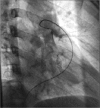Life-threatening hemoptysis: case of Osler-Weber-Rendu Syndrome
- PMID: 29593876
- PMCID: PMC5865522
- DOI: 10.1093/omcr/omx108
Life-threatening hemoptysis: case of Osler-Weber-Rendu Syndrome
Abstract
Hereditary haemorrhagic telangiectasia (HHT), also known as Osler-Weber-Rendu syndrome, is a rare autosomal dominant vascular disorder. Patients with HHT may present with a wide spectrum of clinical manifestations, some considered to be life-threatening. We present the case of a 53-year-old male who presented with massive haemoptysis. Chest computed tomography scan was remarkable for a large anterior, left lower lobe arteriovenous malformation. The patient underwent a pulmonary angiogram with embolization of a large left lung arteriovenous malformation, which proved to be successful in controlling the bleeding.
Figures





Similar articles
-
Life-threatening Anaemia in Patient with Hereditary Haemorrhagic Telangiectasia (Rendu-Osler-Weber Syndrome).Open Med (Wars). 2020 Mar 6;15:134-138. doi: 10.1515/med-2020-0020. eCollection 2020. Open Med (Wars). 2020. PMID: 32190736 Free PMC article.
-
[Hemoptysis in an elderly man with RENDU-Osler-Weber disease].Rev Med Liege. 2015 Jul-Aug;70(7-8):367-70. Rev Med Liege. 2015. PMID: 26376562 French.
-
Spontaneous haemothorax caused by a ruptured pulmonary arterio-venous malformation: A manifestation of hereditary haemorrhagic telangiectasia in pregnancy.Obstet Med. 2024 Jun;17(2):112-115. doi: 10.1177/1753495X221145809. Epub 2022 Dec 15. Obstet Med. 2024. PMID: 38784192 Free PMC article.
-
Pulmonary vascular manifestations of hereditary hemorrhagic telangiectasia (rendu-osler disease).Respiration. 2007;74(4):361-78. doi: 10.1159/000103205. Respiration. 2007. PMID: 17641482 Review.
-
Diagnosis and treatment of pulmonary arteriovenous malformations in hereditary hemorrhagic telangiectasia: An overview.Diagn Interv Imaging. 2013 Sep;94(9):835-48. doi: 10.1016/j.diii.2013.03.014. Epub 2013 Jun 12. Diagn Interv Imaging. 2013. PMID: 23763987 Review.
Cited by
-
Approach to Pulmonary Arteriovenous Malformations: A Comprehensive Update.J Clin Med. 2020 Jun 19;9(6):1927. doi: 10.3390/jcm9061927. J Clin Med. 2020. PMID: 32575535 Free PMC article. Review.
-
A Rare Case of Upper Gastrointestinal Bleeding: Osler-Weber-Rendu Syndrome.Medicina (Kaunas). 2022 Feb 22;58(3):333. doi: 10.3390/medicina58030333. Medicina (Kaunas). 2022. PMID: 35334510 Free PMC article.
-
An Update on Embolization for Pulmonary Arteriovenous Malformations.Interv Radiol (Higashimatsuyama). 2023 Jun 3;8(2):56-63. doi: 10.22575/interventionalradiology.2021-0030. eCollection 2023 Jul 1. Interv Radiol (Higashimatsuyama). 2023. PMID: 37485484 Free PMC article. Review.
References
-
- Shovlin CL. Hereditary haemorrhagic telangiectasia: pathophysiology, diagnosis and treatment. Blood Rev 2010;24:203 DOI:10.1016/j.blre.2010.07.001. - DOI - PubMed
-
- Faughnan ME, Palda VA, Garcia-Tsao G, Geisthoff UW, McDonald J, Proctor DD, et al. . International guidelines for the diagnosis and management of hereditary haemorrhagic telangiectasia. J Med Genet 2011;48:73–87. DOI:10.1136/jmg.2009.069013. - DOI - PubMed
-
- Lacombe P, Lacout A, Marcy PY, Binsse S, Sellier J, Bensalah M, et al. . Diagnosis and treatment of pulmonary arteriovenous malformations in hereditary hemorrhagic telangiectasia: an overview. Diagn Interv Imaging 2013;94:835 DOI:10.1016/j.diii.2013.03.014. - DOI - PubMed
-
- Trembath RC, Thomson JR, Machado RD, Morgan NV, Atkinson C, Winship I, et al. . Clinical and molecular genetic features of pulmonary hypertension in patients with hereditary hemorrhagic telangiectasia. N Engl J Med 2001;345:325–34. DOI:10.1056/NEJM200108023450503. - DOI - PubMed
-
- Cottin V, Chinet T, Lavolé A, Corre R, Marchand E, Reynaud-Gaubert M, et al. . Pulmonary arteriovenous malformations in hereditary hemorrhagic telangiectasia: a series of 126 patients. Medicine (Baltimore) 2007;86:1–17. DOI:10.1097/MD.0b013e31802f8da1. - DOI - PubMed
Publication types
LinkOut - more resources
Full Text Sources
Other Literature Sources

